The word leadership has become such a dirty word in the more progressive circles of dog training. Oh, don’t get me wrong, many qualified dog behavior specialists believe in and advise clients to establish good leadership but usually not with that word. The stigma of a certain TV trainer’s bad advice leads us all to tread lightly where this subject is concerned. So we call it parenting, guiding, coaching, anything but leading. The fear is so great that a mile will be taken when an inch is intended. We have good reason to worry, to be sure. I don’t even pass out my own handout on benevolent leadership anymore. And that theory took center stage in my book.
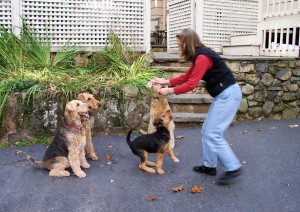
But the fact remains that it actually IS leadership. Good leaders are not scary. They are approachable and friendly and provide safety and security. What’s to be afraid of there? Did you ever have a teacher that you looked up to or were/are you friends with one or both of your parents? That means do you look to them for guidance but also share your fears and successes with them? This is what leadership is about. Providing advice, guidelines, structure and when needed, kindly but firmly pointing you in right direction. Real leaders are never scary or never harmful. Real leaders always lead with love and respect for who you are. This kind of leadership allows the ones being led to spread their wings and find their own niche and make their own choices, always being rewarded for the right choices. Having consequences for the wrong choices as needed, never scary.
My friend, Rachel, recently described a book that she bought on human parenting called Scream Free Parenting. This is a perfect analogy for being your dog crew’s leader. Scream free, force free. But make no mistake, parenting still requires you to be the leader, human or canine kids alike.
Which brings me to the point of this blog post. Leadership is the number one necessity in a multiple dog household with strong canine personalities. There is no getting around that. That IS the elephant in the room in the dog training world. It MUST not be forgotten. It must not be swept under the proverbial rug.
You certainly need training and manners and all that entails. But you need leadership first and foremost. So much of what I do on a daily basis could have been unnecessary with proper leadership from day one. Many of my readers are not human parents. Neither am I but if you have siblings that you possibly did not get along with all the time, maybe this analogy will help. You don’t have to like someone to live with them peacefully. But if you respect the leader of the household and feel safe from harm and all your basic needs are met otherwise, you can stand living with someone you may not enjoy. Sound familiar?
That is why leadership is important in blended households and that is exactly what a multiple dog household often is. Without leadership and manners, things can progress to such a point that takes a huge amount of management, structure and work to fix. Multiple dog household issues run the range of easily fixed with simple tweaks such as adding some leadership to all out dangerous fights on a regular basis where leadership is only the first step. While the latter is unlikely to be fixed when allowed to fester for long periods of time before a professional is called in, some sort of progress can be made in any situation provided the humans are capable of handling the situation.
And this is where leadership comes in. Now a comment that may cause some to get the flamethrowers out: I use body language a lot in multiple dog issues. Heck, I use it with single dog households too. Dogs understand body language far faster than words that we throw at them without applying meaning to such. I don’t use physical corrections or fear for training or management. But I do use body blocks, parental style stances and disapproving looks when appropriate and necessary. And in a multiple dog household, body blocks are something that can be needed on a frequent basis when conflict is happening. It certainly can be used in an very intimidating way as evidenced by that same aforementioned TV trainer. But that isn’t how I use it or teach others to use it. The goal here is to establish that the human is the go to for conflict resolution and safety. The dogs don’t need to handle those things. It should go without saying that any dog whose psyche would be damaged by throwing a parental disapproving stance their way, isn’t the problem child in the household and would never have need of such body language. This is done as a reminder that the human is the final say. Why would that be considered punitive by some circles?
This brings us to the subject of safety. Safety is crucial for all living beings. It’s high up on the pyramid of needs. Take care of that and you can take care of everything that occurs from the lack of safety. So now all that body language that cues the crew to look to you for safety and conflict resolution makes so much more sense than having no consequences for trying to incite conflict. Doesn’t it? Body blocking and splitting on the part of the human is crucial to a harmonious existence in some multiple dog households. I say some because I have seen other trainers say that they never need to use body blocking. They clearly are not working with confident dogs existing together in a conflict riddled household. My goal is as little re-homing as possible when possible.
And just as I would never use a body block with timid dogs who have no need of such a move, I would not dream of not using them in households with dog(s) confident enough to not wilt from such a thing. Establishing or repairing a relationship between the dogs and the humans helps this go smoothly. Keep the safety part in mind. That is what this is all about for all involved.
Body language establishes boundaries that dogs understood very easily. Just as good parents provide non-scary consequences for children who flout perfectly appropriate boundaries, dog parents need to do the same. Doing so provides safety for the one(s) targeted by the bullies, just as with children. Positive never should over permissive. That helps no one, least of all the one(s) with loose boundaries.
I could go on perhaps endlessly on this subject. But in closing, I will allow those who offered me their thoughts on this subject to have their say. Here are their definitions of leadership, though most use a different word to name it. Please feel free t share your own thoughts on this subject in the spaces below as well. But play nice, we are all in this for the sake of the dogs.
From Inna, a trainer in New York City:
With clients I use the term caretaker along with words such as clear guidance and well defined structure. I don’t use words like leader because I don’t want them to associate leader with “Pack leader”. I talk to clients about how important it is for them to help their dogs become the best companions they can be through clear, non violent communication & training.
From Helen, a trainer in Greece:
I consider myself as a parent and friend to my dogs…My role is to protect them, to care for their well being(physical and mental), to guide and educate them, to help them cope with things in life, to love and respect them!
From Jeff, a multiple dog parent in Ohio:
I’d like to think my relationship with my dogs is more of a partnership than anything though. We do this…together. I think it’s how Preston, the girls and I forged the kind of relationship we have. I trust them, and they trust me…therefore they typically do what I ask. Hopefully that makes sense.
From Crystal, a trainer in Indiana, PA:
I do not use the term leader with my clients usually because the word has been poisoned by “dominance” trainers but I use teacher or parent. We protect, we teach, we give them self-sufficiency. Yes, we must have discipline but that means establishing guidelines, not punishing them for our unrealistic expectations. We need to show them that we are steady and reliable, a positive influence in their lives, where to turn when they don’t know what to do. They are foreigners in a world of rules and language that doesn’t make sense to them and we are their guide. Our relationship is like a trust fall, and it is our job to catch them. Every. Time.
From Renee, a trainer in Johnstown, PA:
I use the wording positive leadership with my clients. I was hesitant at first to use the word leadership due to, well we all know why, but I decided to use it to teach a different definition of leadership to pet dog owners than the one they already might know of.
From Andrew, a trainer in Morgantown, WV:
I strive to give my dogs as much freedom of choice as possible, so long as their decisions do not have the potential to harm themselves or others. I foster and encourage appropriate decisions very early on so I have to do very little “active leading” or managing later on. Of course, how much freedom you can give any individual dogs varies, and some dogs prefer more active direction. …I guess I play the role of a cooperative partner…Partnership is the word that comes to mind. Leadership is certainly a component, but I have no problem allowing the dog to take the wheel either. And some situations require active direction, of course.
From Dawn, a trainer in Hawaii:
I don’t give it a label with clients.. I tell people that class is about teaching them to communicate with their dogs and have a relationship. leader/alpha etc. never even comes up. .. I guess even with non parents (before I was a mom still considered myself a dog parent) you can still have them relate to their own parents…… how their parents had rules/structure, etc to keep them safe. or maybe a ‘teacher’. But on the flip side sometimes people need to imagine themselves as a leader in order to understand how to create structure…
From Sue, a multiple dog parent in Georgia:
If I have to put any label on it at all, I’m my dogs’ parent….I have 6 dogs, we still have structure and rules and they look to me for things (to get toys out from under the sofa mostly) and I assume that is true for the way multi-kid families are–I don’t have furless children.
From Karla, a trainer in Virginia:
I am a leader if I have a follower. If I reinforce my dogs engagement with me, he pays attention to my movement, he follows me with his eyes and ears. And if he sees an opportunity for engagement with me, an opportunity for reinforcement, he follows. At those times, I am a leader.
Tags: behavior, canine, choice, direction, dog, dogs, dominance, fears advice, household, leadership, many, multiple, parenting, positive, puppy, respect, social, structure, train, training
Posted in: Projects


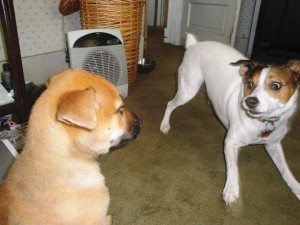

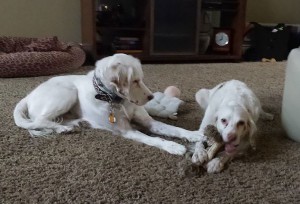

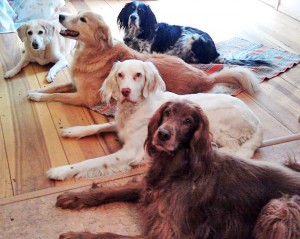

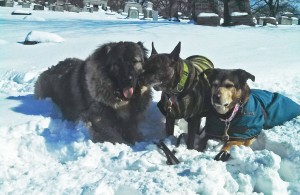
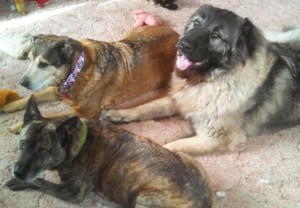 But I am human, I forget. I forgot to say a dog’s name in yesterday’s training session. Instead I simply said “paw”. Siri delivered a right hook to Trent. Poor Trent took it well. They are often offering behaviors without being asked when one is asked. Thankfully, my dogs get along well with each other. So aside from the insulted look on Trent’s face that was there ever so briefly, it’s all good. And I got a fresh reminder that consistency is important on the part of the human.
But I am human, I forget. I forgot to say a dog’s name in yesterday’s training session. Instead I simply said “paw”. Siri delivered a right hook to Trent. Poor Trent took it well. They are often offering behaviors without being asked when one is asked. Thankfully, my dogs get along well with each other. So aside from the insulted look on Trent’s face that was there ever so briefly, it’s all good. And I got a fresh reminder that consistency is important on the part of the human.




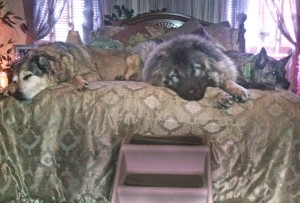 Familial bonding is another often overlooked facet of this scenario. For example, most households have some sort of regular weekday work or school schedule that prevents a lot of bonding and togetherness during the workweek, whether that be weekdays or just several days strung together where the canines in the family get less interaction than they need for emotional stability. Consider then that the dogs in the home may sleep separately from the humans and you have very little togetherness going on.
Familial bonding is another often overlooked facet of this scenario. For example, most households have some sort of regular weekday work or school schedule that prevents a lot of bonding and togetherness during the workweek, whether that be weekdays or just several days strung together where the canines in the family get less interaction than they need for emotional stability. Consider then that the dogs in the home may sleep separately from the humans and you have very little togetherness going on.
